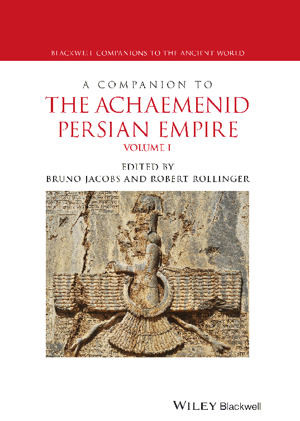Publications so far
0
| 1. |  | Henkelman, Wouter F. M.: Local Administration: Persia. In: A companion to the Achaemenid Persian Empire, vol. 2, pp. 881—904, John Wiley & Sons, 2021. (Type: Book Chapter | Abstract | Links | BibTeX)@inbook{nokey,Two predominantly Elamite archives found at Persepolis are the prime source for the local administration of the Achaemenid heartland per se as well as for the backbone for any socioeconomic history of the empire at large. The sur- vey offered here centers on administrative structures, hierarchies, and proto-cols in relation with other textual sources; it is supplemented by another survey (Henkelman 2013b), focusing on find circumstances, formal charac-teristics, and connections with archeological discoveries (other surveys: Cahill 1985; Briant 2002: pp. 422–471; Henkelman 2008b: pp. 65–179, 2013a; Azzoni et al. 2017; Garrison 2017: pp. 15–116; cf. Kuhrt 2007: pp. 763–825). |
| 2. | Hoffmann, Birgitt: The WaqfnāMa-Yi Rabʿ-I RashīDī – The Most Important Written Source for the Understanding of the Rabʿ-I RashīDī Endowment. In: Proceedings of the First International Conference on the Commemoration of Rashid al-Din Fazl-Allah Hamadani (University of Tabriz, March 2021), pp. 337-348, University of Tabriz Press, Tabriz, 2021. (Type: Book Chapter | BibTeX)@inbook{nokey, | |
| 3. |  | Garrison, Mark B.; Henkelman, Wouter F. M.: Sigillophobe suppliers and Idiosyncratic Scribes: Local Information Handling in Achaemenid Pārsa. In: The art of empire in Achaemenid Persia: Studies in honour of Margaret Cool Root, pp. 167–286, Leiden, 2020. (Type: Book Chapter | Abstract | Links | BibTeX)@inbook{nokey,Greek sources, starting with Herodotus, marvelled about the Persian royal roads and the speed of travel and communication they permitted within the vast Achaemenid expanse. Much has been written about this vital network, the spine of empire: about the degree of connectivity it afforded, about the courses of the roads, the people who travelled on it, and the advantages that Alexander and his armies drew from it. The same Greek sources were much less interested in the logistic operation behind the network, with the notable exception of a passage in Pseudo-Aristotle’s Oeconomica, where Antimenes, a high administrator and Alexander appointee, is said to have bidden “the satraps replenish, in accordance with the law of the country, the storehouses/granaries (θησαυροὺς) along the royal roads.” Though offering little detail, this statement opens a view on the efforts necessary to maintain the way stations with sufficient supplies in flour, wine (or beer), fodder and, in the case of halting places for express messengers, fresh horses. |
2021 |
|
 | Henkelman, Wouter F. M.: Local Administration: Persia. In: A companion to the Achaemenid Persian Empire, vol. 2, pp. 881—904, John Wiley & Sons, 2021. (Type: Book Chapter | Abstract | Links | BibTeX | Tags: Achaemenid, Administration, Clay tablets, Elam, Institutions, Textual sources)@inbook{nokey,Two predominantly Elamite archives found at Persepolis are the prime source for the local administration of the Achaemenid heartland per se as well as for the backbone for any socioeconomic history of the empire at large. The sur- vey offered here centers on administrative structures, hierarchies, and proto-cols in relation with other textual sources; it is supplemented by another survey (Henkelman 2013b), focusing on find circumstances, formal charac-teristics, and connections with archeological discoveries (other surveys: Cahill 1985; Briant 2002: pp. 422–471; Henkelman 2008b: pp. 65–179, 2013a; Azzoni et al. 2017; Garrison 2017: pp. 15–116; cf. Kuhrt 2007: pp. 763–825). |
Hoffmann, Birgitt: The WaqfnāMa-Yi Rabʿ-I RashīDī – The Most Important Written Source for the Understanding of the Rabʿ-I RashīDī Endowment. In: Proceedings of the First International Conference on the Commemoration of Rashid al-Din Fazl-Allah Hamadani (University of Tabriz, March 2021), pp. 337-348, University of Tabriz Press, Tabriz, 2021. (Type: Book Chapter | BibTeX | Tags: Administration, Foundation, Ilkhanate, Institutions, Mongols, Textual sources)@inbook{nokey, | |
2020 |
|
 | Garrison, Mark B.; Henkelman, Wouter F. M.: Sigillophobe suppliers and Idiosyncratic Scribes: Local Information Handling in Achaemenid Pārsa. In: The art of empire in Achaemenid Persia: Studies in honour of Margaret Cool Root, pp. 167–286, Leiden, 2020. (Type: Book Chapter | Abstract | Links | BibTeX | Tags: Achaemenid, Administration, Institutions, Mobility, Structure development, Textual sources)@inbook{nokey,Greek sources, starting with Herodotus, marvelled about the Persian royal roads and the speed of travel and communication they permitted within the vast Achaemenid expanse. Much has been written about this vital network, the spine of empire: about the degree of connectivity it afforded, about the courses of the roads, the people who travelled on it, and the advantages that Alexander and his armies drew from it. The same Greek sources were much less interested in the logistic operation behind the network, with the notable exception of a passage in Pseudo-Aristotle’s Oeconomica, where Antimenes, a high administrator and Alexander appointee, is said to have bidden “the satraps replenish, in accordance with the law of the country, the storehouses/granaries (θησαυροὺς) along the royal roads.” Though offering little detail, this statement opens a view on the efforts necessary to maintain the way stations with sufficient supplies in flour, wine (or beer), fodder and, in the case of halting places for express messengers, fresh horses. |
